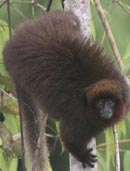Get
To Know
|
 The
Brown Titi Monkey is a New
World primate who lives
in the northern Amazon rainforest of Colombia to Brazil and Peru.
They have a head and body length of 23-46 centimetres and a tail
which is longer than the head and body. The tail is always furry
and is not prehensile. Diurnal and arboreal, titis predominantly
prefer dense forests near water. They easily jump from branch to
branch, earning them their German name, Springaffen (jumping monkeys).
They sleep at night, but also take a midday nap. Titis are territorial.
They live in family groups that consist of parents and their offspring,
about two to seven animals in total. They defend their territory
by shouting and chasing off intruders, but rarely engage in actual
fighting. Their grooming and communication is important for the
co-operation of the group. They can typically be seen in pairs sitting
or sleeping with tails entwined. They
eat mainly fruits, although they also eat leaves, flowers, insects,
bird eggs and small vertebrates.
Titis
are monogamous, mating for life and the female bears a single young
after about a five-month gestation. Twins occur rarely, having been
documented in only 1.4% of all births. While the second infant usually
does not survive, cases where neighbouring groups have adopted infants
are known, suggesting that twins may be reared successfully under
certain circumstances. Often it is the father who cares for the
young, carrying it and bringing it to the mother only for nursing. The
Brown Titi Monkey is a New
World primate who lives
in the northern Amazon rainforest of Colombia to Brazil and Peru.
They have a head and body length of 23-46 centimetres and a tail
which is longer than the head and body. The tail is always furry
and is not prehensile. Diurnal and arboreal, titis predominantly
prefer dense forests near water. They easily jump from branch to
branch, earning them their German name, Springaffen (jumping monkeys).
They sleep at night, but also take a midday nap. Titis are territorial.
They live in family groups that consist of parents and their offspring,
about two to seven animals in total. They defend their territory
by shouting and chasing off intruders, but rarely engage in actual
fighting. Their grooming and communication is important for the
co-operation of the group. They can typically be seen in pairs sitting
or sleeping with tails entwined. They
eat mainly fruits, although they also eat leaves, flowers, insects,
bird eggs and small vertebrates.
Titis
are monogamous, mating for life and the female bears a single young
after about a five-month gestation. Twins occur rarely, having been
documented in only 1.4% of all births. While the second infant usually
does not survive, cases where neighbouring groups have adopted infants
are known, suggesting that twins may be reared successfully under
certain circumstances. Often it is the father who cares for the
young, carrying it and bringing it to the mother only for nursing.
|
|
|
|
Mrs. Padrón had no lesson plan for Tuesday evening's
adult ESL class,
since the former instructor quit abruptly, and she was only called
in to sub
a few hours before. So she stitched together a last-minute lesson
about Thanksgiving. She read from a children's book
telling the Pilgrim & Indian story, quite possibly the half-ancestors
of some of the Mexicali students, made up from indigenous blood
twisted with conquistador. The story predictably sits in the English
corner,
skirts the parts about disease, lays no blame
on the invasive culture. Mrs. Padrón explains to the class
that the Pilgrims wanted to worship their own god, in their own
way,
then asks each student to explain why he or she came
to our Great Nation. Juan Carlos, Peter and Jose all crossed
for better wages, can't wait to find a way back
to their families. Maliya and Prama followed their husbands,
who study medicine at Loma Linda; they miss their homes.
Angel came to take care of his son's new baby, lights up
when he learns the English word "Grandson." Bernice was a bartender
in Rosarito ("Have you been?," she winks, we laugh),
where a coed from Redlands fell hard and fast. He drove down every
weekend,
she says, for six years. She finally agreed to marry him, and
when
she got pregnant with their son, she came to the States.
Then Mrs. Padrón asks the class what they are thankful for. Students
say
everything, every single day. They say family, shelter, sustenance.
"The sun rises every morning," Bernice waves her hands, "and I
have two eyes to see it." The beam
that sweetens each face, takes the edge
from the Pilgrimage--perhaps reminds
the night class
why they try.
Jessica Morey-Collins is a Southern California poet currently writing
from Shanghai, China. Her work has been featured in The Literary
Bohemian, Cordite, Welter, The Smoking Poet and elsewhere.
|
 The
Brown Titi Monkey - Issue Fourteen
The
Brown Titi Monkey - Issue Fourteen